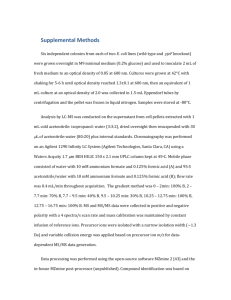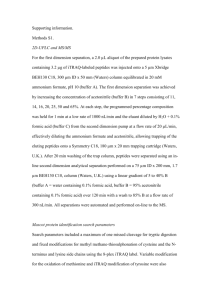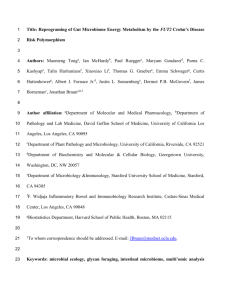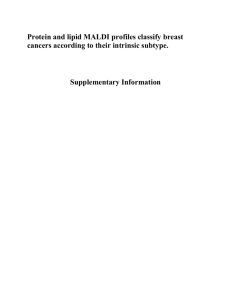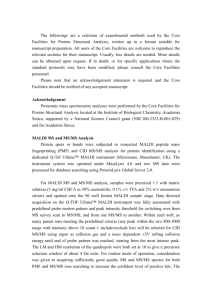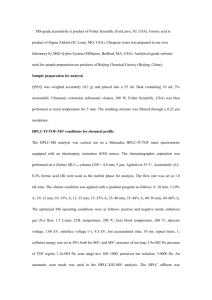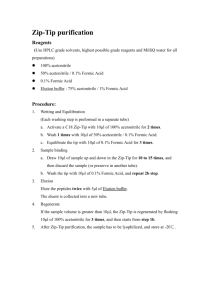Methods_for_Manuscript
advertisement
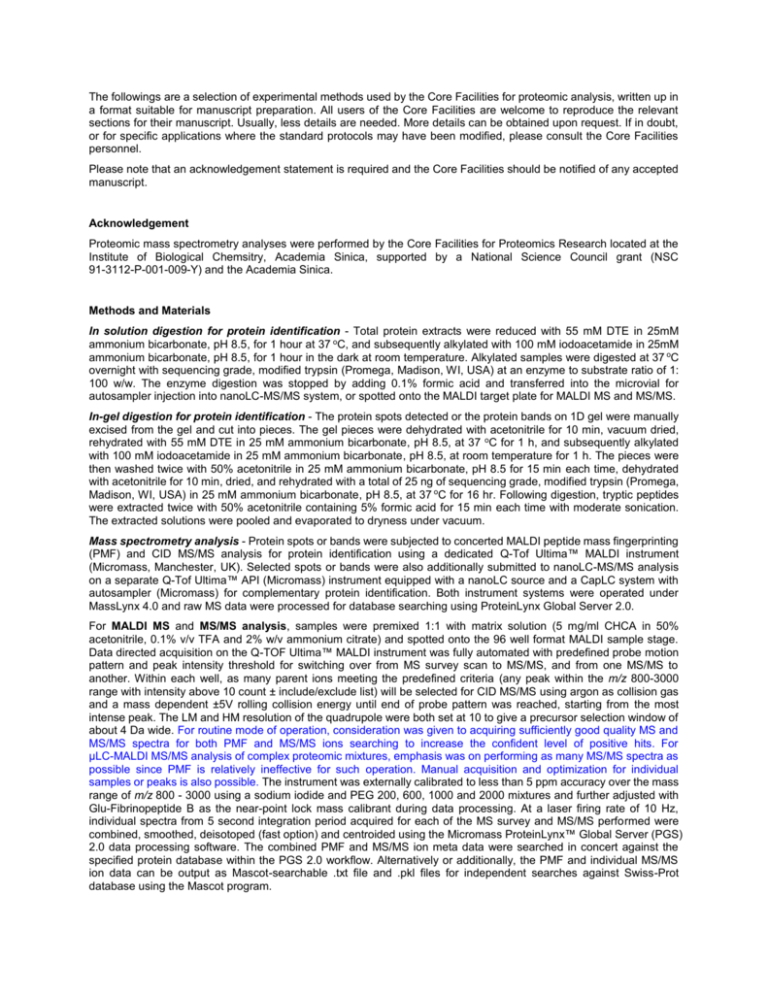
The followings are a selection of experimental methods used by the Core Facilities for proteomic analysis, written up in a format suitable for manuscript preparation. All users of the Core Facilities are welcome to reproduce the relevant sections for their manuscript. Usually, less details are needed. More details can be obtained upon request. If in doubt, or for specific applications where the standard protocols may have been modified, please consult the Core Facilities personnel. Please note that an acknowledgement statement is required and the Core Facilities should be notified of any accepted manuscript. Acknowledgement Proteomic mass spectrometry analyses were performed by the Core Facilities for Proteomics Research located at the Institute of Biological Chemsitry, Academia Sinica, supported by a National Science Council grant (NSC 91-3112-P-001-009-Y) and the Academia Sinica. Methods and Materials In solution digestion for protein identification - Total protein extracts were reduced with 55 mM DTE in 25mM ammonium bicarbonate, pH 8.5, for 1 hour at 37 oC, and subsequently alkylated with 100 mM iodoacetamide in 25mM ammonium bicarbonate, pH 8.5, for 1 hour in the dark at room temperature. Alkylated samples were digested at 37 oC overnight with sequencing grade, modified trypsin (Promega, Madison, WI, USA) at an enzyme to substrate ratio of 1: 100 w/w. The enzyme digestion was stopped by adding 0.1% formic acid and transferred into the microvial for autosampler injection into nanoLC-MS/MS system, or spotted onto the MALDI target plate for MALDI MS and MS/MS. In-gel digestion for protein identification - The protein spots detected or the protein bands on 1D gel were manually excised from the gel and cut into pieces. The gel pieces were dehydrated with acetonitrile for 10 min, vacuum dried, rehydrated with 55 mM DTE in 25 mM ammonium bicarbonate, pH 8.5, at 37 oC for 1 h, and subsequently alkylated with 100 mM iodoacetamide in 25 mM ammonium bicarbonate, pH 8.5, at room temperature for 1 h. The pieces were then washed twice with 50% acetonitrile in 25 mM ammonium bicarbonate, pH 8.5 for 15 min each time, dehydrated with acetonitrile for 10 min, dried, and rehydrated with a total of 25 ng of sequencing grade, modified trypsin (Promega, Madison, WI, USA) in 25 mM ammonium bicarbonate, pH 8.5, at 37 oC for 16 hr. Following digestion, tryptic peptides were extracted twice with 50% acetonitrile containing 5% formic acid for 15 min each time with moderate sonication. The extracted solutions were pooled and evaporated to dryness under vacuum. Mass spectrometry analysis - Protein spots or bands were subjected to concerted MALDI peptide mass fingerprinting (PMF) and CID MS/MS analysis for protein identification using a dedicated Q-Tof Ultima™ MALDI instrument (Micromass, Manchester, UK). Selected spots or bands were also additionally submitted to nanoLC-MS/MS analysis on a separate Q-Tof Ultima™ API (Micromass) instrument equipped with a nanoLC source and a CapLC system with autosampler (Micromass) for complementary protein identification. Both instrument systems were operated under MassLynx 4.0 and raw MS data were processed for database searching using ProteinLynx Global Server 2.0. For MALDI MS and MS/MS analysis, samples were premixed 1:1 with matrix solution (5 mg/ml CHCA in 50% acetonitrile, 0.1% v/v TFA and 2% w/v ammonium citrate) and spotted onto the 96 well format MALDI sample stage. Data directed acquisition on the Q-TOF Ultima™ MALDI instrument was fully automated with predefined probe motion pattern and peak intensity threshold for switching over from MS survey scan to MS/MS, and from one MS/MS to another. Within each well, as many parent ions meeting the predefined criteria (any peak within the m/z 800-3000 range with intensity above 10 count ± include/exclude list) will be selected for CID MS/MS using argon as collision gas and a mass dependent ±5V rolling collision energy until end of probe pattern was reached, starting from the most intense peak. The LM and HM resolution of the quadrupole were both set at 10 to give a precursor selection window of about 4 Da wide. For routine mode of operation, consideration was given to acquiring sufficiently good quality MS and MS/MS spectra for both PMF and MS/MS ions searching to increase the confident level of positive hits. For μLC-MALDI MS/MS analysis of complex proteomic mixtures, emphasis was on performing as many MS/MS spectra as possible since PMF is relatively ineffective for such operation. Manual acquisition and optimization for individual samples or peaks is also possible. The instrument was externally calibrated to less than 5 ppm accuracy over the mass range of m/z 800 - 3000 using a sodium iodide and PEG 200, 600, 1000 and 2000 mixtures and further adjusted with Glu-Fibrinopeptide B as the near-point lock mass calibrant during data processing. At a laser firing rate of 10 Hz, individual spectra from 5 second integration period acquired for each of the MS survey and MS/MS performed were combined, smoothed, deisotoped (fast option) and centroided using the Micromass ProteinLynx™ Global Server (PGS) 2.0 data processing software. The combined PMF and MS/MS ion meta data were searched in concert against the specified protein database within the PGS 2.0 workflow. Alternatively or additionally, the PMF and individual MS/MS ion data can be output as Mascot-searchable .txt file and .pkl files for independent searches against Swiss-Prot database using the Mascot program. 1D LC-nanoESI-MS/MS analysis was performed on an integrated nanoLC-MS/MS system (Mircomass) comprising a 3-pumping Micromass/Waters CapLC™ system with an autosampler, a stream select module configured for precolumn plus analytical capillary column, and a Micromass Q-Tof Ultima™ API mass spectrometer fitted with nano-LC sprayer, operated under MassLynx™ 4.0 control. Injected samples were first trapped and desalted isocratically on an LC-Packings PepMap™ C18 μ-Precolumn™ Cartidge (5 μm, 300 μm I.D. x 5mm; Dionex, Sunnyvale, CA, USA) for 2 min with 0.1% formic acid delivered by the auxillary pump at 30 μl/min after which the peptides were eluted off from the precolumn and separated on an analytical C18 capillary column (15 cm x 75 μm i.D., packed with 5 μm, Zorbax 300 SB C18 paticles,; Micro-Tech Scientific, Vista, CA, USA) connected inline to the mass spectrometer, at 300 nl/min using a 40 min fast gradient of 5% to 80% acetonitrile in 0.1% formic acid. For more extensive coverage, detection of modifications, or analyses of complex proteomic mixtures, longer gradient lasting up to 120 min or 2D LC were applied. For 2D LC-nanoESI-MS/MS analysis, a 4-pumping Ultra-Plus™ II system (Micro-Tech Scientific) was connected to the Q-Tof Ultima™ API mass spectrometer in place of the Micromass CapLC™ system. A first dimension strong cation exchange (SCX) column (10 cm x 320 μm I.D., packed with 5 μm, 300 Å polysulfoethyl aspartamide material, Micro-Tech Scientific) was coupled to a second dimension reverse phase C18 analytical column (15 cm x 75 μm i.D., packed with 5 μm, Zorbax 300 SB C18 paticles, Micro-Tech Scientific) via two alternative C18 trapping cartridges (LC-Packings PepMap™ C18 μ-Precolumn™, 5 μm, 300 μm I.D. x 5mm, Dionex). Samples were first loaded in 0.1% formic acid (0 salt, step 1) at 10 μl/min onto the SCX column. A total of 7 salt steps at 1.25 mM, 2.5 mM, 6.25 mM, 12.5 mM, 25 mM, 62.5 mM, and 125 mM ammonium acetate in 0.1% formic acid (steps 2-8) were then used to sequentially elute the peptides off the SCX column using pumps C and D. Eluates from SCX column in steps 1, 3, 5 and 7 were trapped and desalted in the first precolumn while those from steps 2, 4, 6 and 8 were trapped in the other precolumn as controlled by a ten-port switch valve which also allowed pumps A and B to deliver a 60 min gradient of 5% to 80% acetonitrile in 0.1% formic acid to elute off the washed peptide samples alternatively from the two precolumns to the mass spectrometer via the analytical column. Online nanoESI-MS survey scan and data dependent acquisition of CID MS/MS were fully automated and synchronized with the nanoLC runs under the full software control of MassLynx™ 4.0. Prior to online analysis, the nanoLC sprayer and Z-spray source parameters were tuned and optimized with glufibrinopeptide B. Argon was used as the collision gas for CID MS/MS. Calibration was performed using the product ions generated from fragmentation of the doubly charged molecular ion of glufibrinopeptide B at m/z 785.8. For routine protein identification analysis, the 1 s survey scans were acquired over the mass range m/z 400 – 2000 and a maximum of 3 concurrent MS/MS acquisitions could be triggered for 2+, 3+ and 4+ charged precursors detected at an intensity above the predefined threshold. Each MS/MS acquisition will be completed and switch back to survey scan when the precursor intensity fell below a predefined threshold or after a maximum of 6 s acquisition. After data acquisition, the individual MS/MS spectra acquired for each of the precursors within a single LC run were combined, smoothed, deisotoped (fast option, inclusive of simple transformation of multiply charged peaks) and centroided using the Micromass ProteinLynx™ Global Server (PGS) 2.0 data processing software and output as a single Mascot-searchable peak list (.pkl) file. In the case of 2D LC, each of the salt steps was considered as separate 1D LC-MS/MS run and yielded a separate peak list file. All peak list files thus generated for the 2D LC run were manually combined into one single .pkl file. The peak list files were used to query the Swiss-Prot database using the Mascot program with the following parameters : peptide mass tolerance, 50 ppm; MS/MS ion mass tolerance, 0.25 Da; allow up to one missed cleavage; variable modifications considered were methionine oxidation and cysteine carboxyamidomethylation. Only significant hits as defined by Mascot probability analysis will be considered initially. In addition, a minimum total score of 20 comprising at least a peptide match of ion score more than 20 was arbitrarily set as the threshold for acceptance. In cases where the protein was mainly identified by a single peptide match of low score, the MS/MS ions were manually examined for notable sequence tag and independently verified using the Pepsea program.
